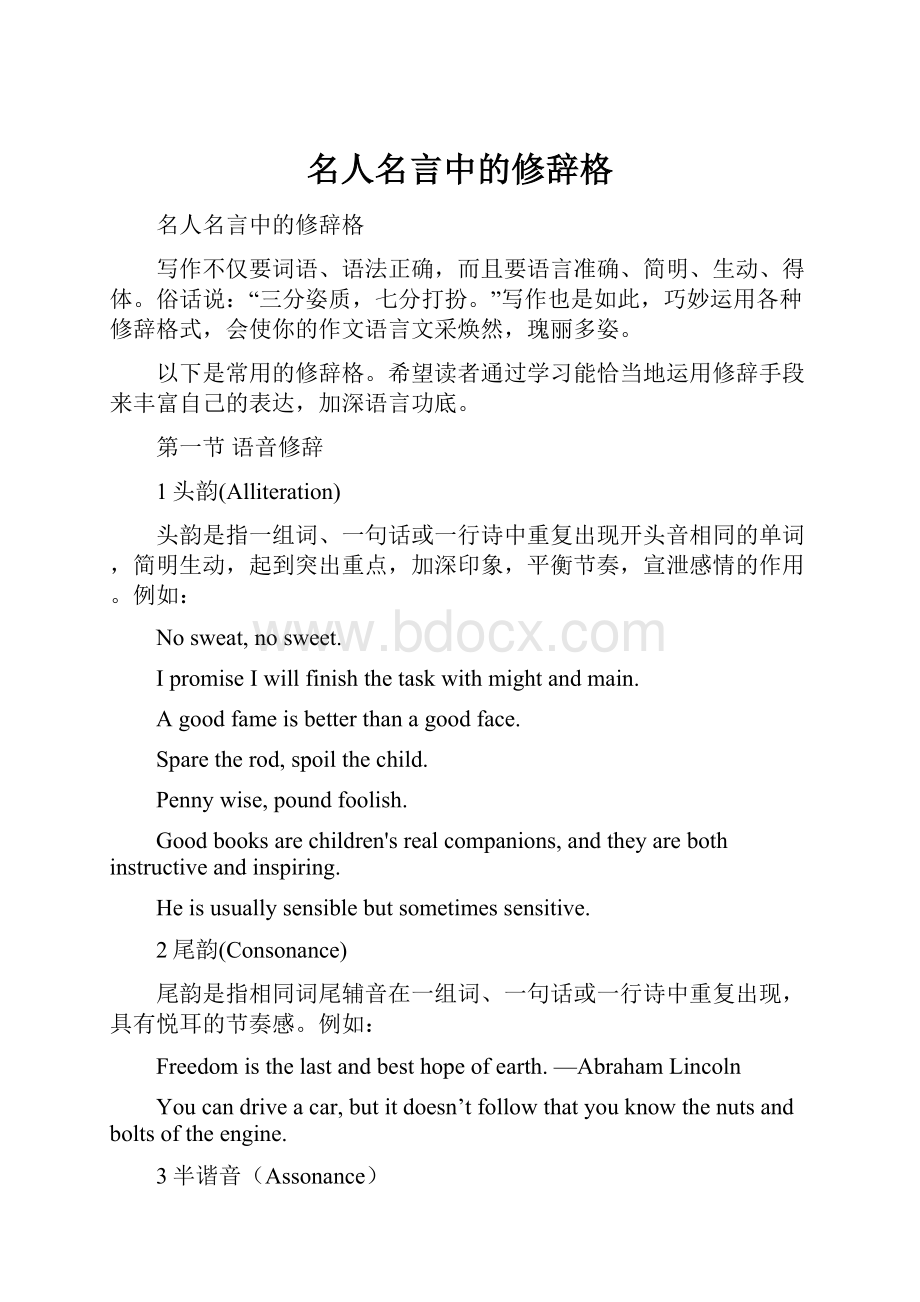名人名言中的修辞格.docx
《名人名言中的修辞格.docx》由会员分享,可在线阅读,更多相关《名人名言中的修辞格.docx(15页珍藏版)》请在冰豆网上搜索。

名人名言中的修辞格
名人名言中的修辞格
写作不仅要词语、语法正确,而且要语言准确、简明、生动、得体。
俗话说:
“三分姿质,七分打扮。
”写作也是如此,巧妙运用各种修辞格式,会使你的作文语言文采焕然,瑰丽多姿。
以下是常用的修辞格。
希望读者通过学习能恰当地运用修辞手段来丰富自己的表达,加深语言功底。
第一节语音修辞
1头韵(Alliteration)
头韵是指一组词、一句话或一行诗中重复出现开头音相同的单词,简明生动,起到突出重点,加深印象,平衡节奏,宣泄感情的作用。
例如:
Nosweat,nosweet.
IpromiseIwill finishthetask withmightandmain.
A good fame is better than a good face.
Sparetherod,spoilthechild.
Pennywise,poundfoolish.
Goodbooksarechildren'srealcompanions,andtheyarebothinstructiveandinspiring.
Heisusuallysensiblebutsometimessensitive.
2尾韵(Consonance)
尾韵是指相同词尾辅音在一组词、一句话或一行诗中重复出现,具有悦耳的节奏感。
例如:
Freedomisthelastandbesthopeofearth.—AbrahamLincoln
Youcandriveacar,butitdoesn’tfollowthatyouknowthenutsandboltsoftheengine.
3半谐音(Assonance)
半谐音也可称“元韵”或“类韵”。
是指一组词、一句话或一行诗中几个相邻词的元音相似或相同但是前后辅音不同重复出现,它具有音乐的节奏感,可增强语言的表现力。
例如:
AllroadsleadtoRome.
Acitythatissetonahillcannotbehid.
4谐缀(Homoeotoleuton)
谐缀是指利用词组或句子尾词中相同或相似后缀音构成的语音修辞格,放在诗歌中的句尾就是通常我们所说的押韵。
例如:
Earlytobedandearlytorise,makesamanhealthy,wealthy,andwise.
早睡早起使人健康、富裕又聪明。
——BenjaminFranklin富兰克林
5拟声(Onomatopoeia)
拟声是指利用词的发音模仿人、动物或其他事物声音特点的辞格。
它可以使语音生动、形象、逼真。
拟声中多用名词、动词或副词。
Icanhearthewatersplashing,thebeeshumming,andthefrogscroaking.
Theaudiencecheeredandclapped.
Thesteamescapedwithaloudhissingnoise.
Over150personswerekilledintheaircrashin JapanaccordingtothelatestCNNNews.
Iheardtheclock’sticktack,andtimewentby.
Thelittlegirlgiggledwhenshesawthefunnyclown.
Shebangedherkneeagainstatable.
Thefrogswerecroaking inthepondwhilethedogswerebarkingintheyard.
TheicecrackedasIsteppedontoit.
Thedoorcreakedopen.
Engineswerechuggingawaybesidethewells.
Hewhisperedmewhathadhappened.
Hefloppeddownthebagandrantohelpus.
Thatbirdisflying.Icanseeitswingsflapping.
Theangryhusbandshutthedoorwithabang.
第二节语义修辞
1明喻(Simile)
明喻是一种最简单、最常见的修辞方法,是以两种具有共同特征的事物或现象进行对比,表明本体和喻体的关系,两者都在对比中出现,其基本格式是“A像B”,常用的比喻词有as,like,asif,asthough等。
例如:
Livingwithoutanaimislikesailingwithoutacompass.
生活而无目标,犹如航海之无指南针。
——J.Ruskin鲁斯金
Ilikethedreamsofthefuturebetterthanthehistoryofthepast.
我不缅怀过去的历史,而致力于未来的梦想。
——T.Jefferson
2暗喻(Metaphor)
暗喻也是一种比喻,但不用比喻词,因此被称作缩减了的明喻(acompressedsimile)。
它直接把一种事物名称用在另一事物上,从而更生动、更深刻地说明事理,增强语言的表现力。
例如:
Timeismoney.
时间就是金钱。
——BenjaminFranklin富兰克林
Death…isnomorethanpassingfromoneroomintoanother.
死亡只不过是从一个房间进入另一个房间。
——HelenKeller
Knowledgeisatreasure,butpracticeisthekeytoit.
知识是一宝库,而实践就是开启宝库大门的钥匙。
——Fuller
Alltheworld’sastage,andallthemenandwomenmerelyplayers.—WilliamShakespeare
3转喻(Metonymy)
转喻是通过相近的联想,借喻体代替本体。
例如:
IamdrinkingNestle.
Iwon’tletmyheartrulemyhead.
WillMozartbeplayedattheconcert?
Thecollegestudentsliveintheivorytower.
Itissaidthatheruledthecompanywithanironfist.
Hiswalletwouldnotallowhimthatluxury.
Hesucceededtothecrownin1848.
IenjoyedreadingTagoreespeciallyinsuchalovelyseasonlikeearlyspring.
Greyhairsshouldberespected.
Beneaththeruleofmenentirelygreat,thepenismightierthanthesword.
Shewas,tobesure,agirlwhoexcitedtheemotions,butIwasnotonetoletmyheartrulemyhead.
Everythinggoesperfectexceptthelastbeat.
Heisfoundofthebottle.
4提喻(Synecdoche)
提喻是用部分代全体或用全体代部分。
Theysaythere'sbreadandworkforall.
Shewasdressedinsilk.
Ahandisneededinourworkshop.
Twoheadsarebetterthanone.
Hetoiledalldaylongtoearnhisbread.
ItwasreportedthatKoreabeatChinainasoccergameyesterday.
Class1issuperiortoClass2inthecrosswordgames.
ItalybeatFranceintheWorldCupFinals
Hehastoworkhardbecausehehasgotfivemouthstofeed.
Therewasn’tasailinsight.
Greatmindsthinkalike.
5移就(Transferredepithet)
移就指的是作为修饰语的形容词与被修饰语没有逻辑关系,但起到了通感的作用。
其特点是把人的感觉沟通用于描摹客观事物形象,表现主观心理感受。
例如:
Helayinbed,smokinghisthinkingpipe.
Theyareindeepfriendship.
Theyhadtobearpitilesswindatnight.
Therewasashortthoughtfulsilence.
Anexpensivefailurecanbemadeintoanassetifyou'velearntfromit.
Peoplelistenedwithopen-mouthedastonishmentwhiletheshockingnewssankin.
Heclosedhisbusylifeattheageof80.
Themomenthesawus,hegaveusasunnysmile.
Thephotorecordedmanyhopefuleyesofthesmallvillage.
Thisisthecheapestmarketinthiscountry.
Theoldmanputareassuringhandonmyshoulder.
Theoldmanlayallnightonhissleeplessbed.
Thequestionwasmetwithanawkwardsilence.
6通感(Synaesthesia)
通感是指在日常经验里,视觉、听觉、触觉、嗅觉、味觉往往可以彼此打动或交通,眼、耳、舌、鼻、身各个官能的领域可以不分界限。
例如:
Theflowerssmellsweet.
Shesaid“Hello”tomewithasweetsmile.
Shehasasoftvoice.
7拟人(Personification)
拟人是把人类的特点、特性加于外界事物上,使之人格化的修辞格。
运用“拟人”可以使抽象的事物具体化,使无生命的东西活跃起来,增强语言的鲜明性、形象性和生动性。
例如:
Loveruleshiskingdomwithoutasword.
爱,统治了他的王国,不用一枝利剑。
——Herbert赫伯特
Timeandtidewaitfornoman.
时间不等人。
——Scott斯科特
8拟物(Zoosemy)
同拟人相反,拟物是把人当成物来描写,包括描写成动物、植物、无生命物、抽象概念等。
例如:
Heisawolfinsheep’sclothes.
Sheissheddingcrocodiletears.
“Aluckydogyouare!
”exclaimedJohn.
Heisabookworm.
Childrenareflowersofourcountry.
9夸张(Hyperbole)
夸张是一种故意言过其实,或夸大或缩小事物的形象,借以突出事物的某种特征或品格,鲜明地表达思想情感的修辞方式。
用于描写可以使形象更生动突出,渲染气氛,烘托意境,给读者留下深刻、鲜明的印象。
例如:
JohnwasmadforthegreatachievementhehadmadeinIBM.
Onefatherismorethanahundredschoolmasters.
Somemoviestarsweartheirsunglasseseveninchurches;they’reafraidthatGodmightrecognizethemandaskforautograph.
Hiswordsmademybloodfreeze.
10双关(Pun)
双关是指同形异义词(homonym)或同音异义(homophone)词的巧妙使用,是一种文字游戏。
它的效果是使语言生动幽默。
例如:
Theblindmancanalwaysseehisfatherbecausethefatherisapparent(aparent).
Sevendayswithoutwatermakeoneweak(week).
Acannonballtookoffhislegs,sohelaiddownhisarms.
Askformetomorrowandyoushallfindmeagraveman.
WhenTomaskedwhetherIhadmissedthefootballmatchyesterday,IsaidthatImissedmygirlfriend.
Cokerefreshesyoulikenoothercan.(advertisement)
Alliswellthatendswell.(cigaretteadvertisement)
Fromsharpminds,comeSharpproducts.(Sharpadvertisement)
11曲言(Litotes)
曲言是通过否定反面来表达肯定的意思,也叫间接肯定法。
例如:
Thisisnosmall(abig)problem.
Hewasamanofnomeanwealth.(Hewasquiterich.)
It'snolaughingmatter.(It'saseriousmatter.)
Today’shomeworkisnoeasy(difficult)tofinish.
Itisnotright(wrong)tomockatcripples.
12仿拟(Parody)
仿拟是根据家喻户晓的成语或谚语,临时更换其中的某个部分,造成新的成语或谚语;或者根据古今名言警句,在保持其原句不变的情况下,更换其中部分词语,这种修辞方式叫仿拟。
例如:
WheninChina,doasChinesedo.(WheninRome,doasRomansdo.)
Wherethereisafriend,thereisafavor.(Wherethereisawill,thereisaway.)
Wherethereis awish,thereisadream.
Wherethereisawill,thereisalawsuit.
Betterlatethanthelate.(AsloganonaUShighway“晚了总比完了好”,from“Betterlatethannever”)
Outofclassroom,outofcontrol.(Outofsight,outofmind.)
Fameandfortunewaitfornoman.(Timeandtidewaitfornoman.)
13矛盾修辞法(Oxymoron)
矛盾修辞法是修饰语和被修饰语具有两种不相调和,甚至截然相反的特征。
这种方法在矛盾中寻求哲理,语言精炼简洁,富有哲理,并产生强大的逻辑力量,产生一种出人意料,引人入胜的效果。
例如:
Hesatthereandwatchedthem,sochangelesslychanging,sobrightanddark,sograveandgay.
Hemethissonwithpainfulpleasure.
Tome,youareafamiliarstranger.
Itissaidthatapublicforbiddencastlehasbeenbuiltupinthatcountry.
Themotherisundergoingthejoyfulpain,andthepainfuljoyofchildbirth.
Iwon’tsay“yes”andIwon’tsay“No”,butI’mgivingyouadefinite“Maybe”.
anexpectedaccident/surprise
busyidleness
virtualreality
oldnews
14隽语(Paradox)
隽语是指似非而是,表达一个意味深长的意思的修辞格。
例如:
Amanofgreatwisdomoftenseemsslowwitted.
Afriendwhoalwayscomplimentsyouisnotatruefriend.
Whatimportantisnotthelengthofthelife,butthewidthofthelife.
15委婉(Euphemism)
委婉是用较委婉、文雅的方法去表达不体面的事的修辞格。
例如:
Theboyusedtotakethingswithoutpermission(stealthings).
I’mafraidshecan’tactthatpart—sheisalittleontheplumpside(fat).
Hewasn’tembarrassedbyherlow-income(poverty,anddecidedtomarryhersoon.
Jackson,ablackbroughtupintheinnercity(slum),ranswiftlyalongthetrackandbeatalltheothers.
Jackisregardedasaslow(foolish)studentinourclass.
Hisfatherwenttotheheaven(died)yesterday.
Oneofhisearscannothearthesound(isdeaf).
landscapearchitect(gardener)
soulsister(blackwoman)
sanitationengineer(garbageman)
thedisadvantaged(thepoor)
industrialaction(strike)
16拈连(Zeugma)
甲乙两个事物连在一起叙述时,把本来只适用于甲事物的词语拈来用到乙事物上,这种修辞手法就叫拈连。
例如:
Sheopenedthedoorandherhearttothehomelessboy.
Fredexcelledatsports;Harveyateating;Tomwithgirls.
Withonemightyswingheknockedtheballthroughthewindowandtwospectatorsofftheirchairs.
Helosthiscoatandhistemper.
Thissuitfitsthemanandthetimes.
Sherosefromthetableagitated,andwenthomestraightly,inafloodoftearsandasedanchair.
Oldpeoplegatheredinthehallforreunionandahotlunch.
Tenminuteslater,thecoffeeandthecommanderarrivedsimultaneously.
17同源(Paregmenon)
同源指词汇中音义相关、由同一语源派生的词。
例如:
Cowardsdiemanytimesbeforetheirdeaths.
懦夫在未死之前,已身历多次死亡的恐怖了。
——JuliusCaesar凯撒
18对比(Contrast)
对比是把对立的意思或事物、或把事物的两个方面放在一起作比较,让读者在比较中分清好坏、辨别是非。
例如:
Abirdinthehandisworthtwointhebush.
手中的一只鸟胜于林中的两只鸟。
——Heywood希伍德
.Agreatmanisalwayswillingtobelittle.
伟大的人物总是愿意当小人物的。
——R.W.Emerson爱默生
Thatistheessenceofscience:
askanimpertinentquestion,andyouareonthewaytothepertinentanswer.
科学的本质是:
问一个不恰当的问题,于是走上了通往恰当答案的路。
——JacobBronowski
第三节话语结构修辞
1松散句(Loosesentence)
松散句是把主要的思想放在句子开头直接陈述,把次要的思想作为补充放在后面的一种句式。
英语中常见的句子